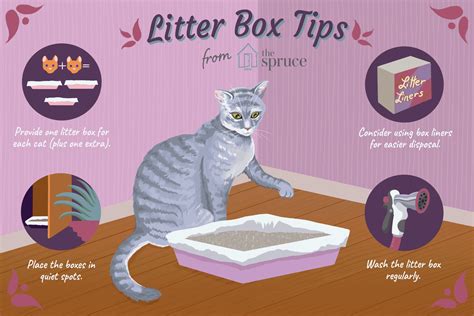Introduction
Maintaining a clean and hygienic cat litter box is crucial for the health and well-being of your feline friend. A well-maintained litter box prevents odors, reduces the risk of infections, and ensures your cat’s comfort. This comprehensive guide will provide you with all the essential information you need to keep your cat’s litter box in pristine condition.

Number of Litter Boxes
The golden rule for determining the optimal number of litter boxes is “n+1,” where “n” is the number of cats in your household. For example, if you have three cats, you should have four litter boxes. This allows your cats to have a designated space for elimination and reduces the likelihood of accidents.
Box Size and Location
Choose a litter box that is large enough for your cat to move around comfortably. The ideal size is 1.5 times the length of your cat from nose to tail. Place the litter boxes in quiet, private locations where your cat feels safe and undisturbed. Avoid placing litter boxes next to noisy appliances or high-traffic areas.
Type of Litter
There are numerous types of litter available, including clay, crystal, silica gel, and pine pellets. Each type has its pros and cons, so choose the one that best suits your cat’s preferences and your budget.
Frequency of Cleaning
The frequency of cleaning depends on the number of cats using the litter box and the type of litter used. Generally, it’s recommended to scoop the solids out daily and completely replace the litter every 1-2 weeks. Use a litter scoop with small holes to remove clumps effectively.
Disposal of Waste
Dispose of cat waste properly to prevent the spread of bacteria and parasites. You can flush biodegradable litter down the toilet or wrap it in a plastic bag and dispose of it in the trash. Do not compost cat waste because it contains pathogens that can harm humans and plants.
Common Mistakes to Avoid
- Ignoring the “n+1” rule: Having too few litter boxes can lead to stress, accidents, and urinary tract issues in cats.
- Using the wrong type of litter: Some cats are sensitive to certain types of litter, so it’s important to observe your cat’s preferences and choose a litter that doesn’t irritate them.
- Not cleaning the litter box regularly: A dirty litter box can deter cats from using it, leading to inappropriate elimination and unpleasant odors.
- Using scented litter: While scented litter may mask odors, it can be overpowering and irritating for cats.
- Placing the litter box in an inconvenient location: Cats prefer privacy when doing their business, so ensure the litter box is located in a quiet and secluded spot.
FAQs
- Why does my cat avoid the litter box? Reasons could include a dirty litter box, an inappropriate litter type, a medical condition, or stress.
- How often should I replace the litter box itself? Most litter boxes last for 6-12 months before they need to be replaced.
- Can I use human litter for my cat? No, human litter is not suitable for cats as it can be toxic and irritating.
- What are the signs of a urinary tract infection in cats? Symptoms include frequent urination, straining to urinate, and bloody or cloudy urine.
- How do I get my cat to use a new litter box? Place the new litter box next to the old one and gradually transition your cat by adding a small amount of the new litter to the old litter each day.
- What is the best way to deal with cat litter odor? Scoop the solids daily, replace the litter regularly, and use an odor-absorbing litter or baking soda in the litter box.
Conclusion
By following the principles outlined in this guide, you can maintain a hygienic and odor-free litter box that your cat will appreciate. Remember, a clean litter box is essential for your cat’s physical and emotional well-being. By taking proper care of your cat’s litter box, you’re ensuring a happy, healthy, and harmonious relationship with your feline companion.
Tables
Table 1: Types of Cat Litter and Their Pros and Cons
| Litter Type | Pros | Cons |
|---|---|---|
| Clay | Affordable, absorbs well | Dusty, heavy |
| Crystal | Odor-absorbing, low-tracking | Can be sharp |
| Silica Gel | Highly absorbent, odor-controlling | Expensive |
| Pine Pellets | Natural, biodegradable | Can be messy |
Table 2: How Often to Clean the Litter Box
| Number of Cats | Scoop Solids | Replace Litter |
|---|---|---|
| 1 | Daily | 1-2 weeks |
| 2 | Twice a day | Every 5-7 days |
| 3+ | Three times a day | Every 3-5 days |
Table 3: Recommended Litter Box Size
| Cat Size (Nose to Tail) | Litter Box Length |
|—|—|—|
| < 20 inches | 18-24 inches |
| 20-24 inches | 24-30 inches |
| 25+ inches | 30+ inches |
Table 4: Signs of a Urinary Tract Infection in Cats
| Symptom | Description |
|—|—|—|
| Frequent urination | Urinating more often than usual |
| Straining to urinate | Difficulty or discomfort while urinating |
| Bloody or cloudy urine | Blood or sediment in the urine |
| Crying or discomfort | Vocalization or signs of pain while urinating |
| Increased urination outside the litter box | Inappropriate elimination due to discomfort |





















